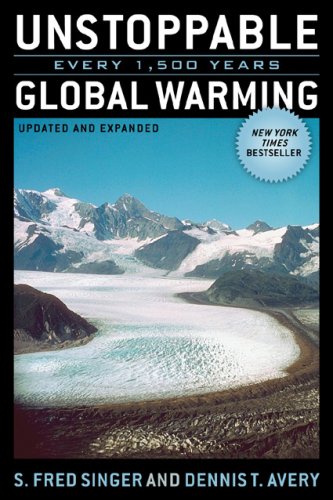

| UNSTOPPABLE GLOBAL WARMING (rev. ed.) Every 1,500 Years S. Fred Singer Dennis T. Avery Joseph L. Bast (Fwd.) Lanham, MD: Rowman & Littlefield, October 2007 |
Rating: 1.0 Poor |
|||
| ISBN-13 978-0-7425-5124-4 | ||||
| ISBN 0-7425-5124-5 | 278pp. | SC/BWI | $21.95 | |
| Page xvii: | "Sailing their longships west from Iceland in circa 985, the Vikings had been pleased to find a huge new uninhabited island..." |
| Extra word: S/B "circa 985". |
| Page xix: | "540 million years ago: Earth apparently turned from 'ice ball' into a warm and humid world. Simple microbes in the ocean transform into thousands of new species, founding the evolution of today's life forms." |
| Improper tense: S/B "transformed". This is only one example of the improper use of present tense in the "Ancient Climate History" timeline on pages xix-xxi. |
| Page 26: | "The team ran their idea on a computer model. It worked." |
| Can we take this as invalidating the authors' claim that climate models are untrustworthy? |
| Page 44: | "The trees are unequivocal that something quite terrible happened," asserts Baillie. "Not only in Northern Ireland and Britain, but right across northern Siberia, North and South America, a global event of some kind [occurred]." in circa 985, the Vikings had been pleased to find a huge new uninhabited island..." |
| This quotation by Michael Baillie of Northern Ireland's Queens University is taken from a BBC News broadcast: "Tree Rings Challenge History," 8 September 2000. Not only does it provide no support for the claim that the "something quite terrible" was global in extent, but its use of tree rings is unquestioned, unlike Michael Mann's use of the same sort of proxy data. |
| Page 58: | "Neither the Medieval Warming nor the Little Ice Age was a precise, consistent event. Only in retrospect can we say that the Little Ice Age ended about 1850. Variability remains the foremost characteristic of weather, and it takes at least a century of weather data to evaluate climate trends." |
| Yet on page xxii the authors posit recent climate trends of 90, 35, 2, and 29 years in duration, respectively (the last based on the book's publication date.) See also page vii of the Foreword, where Joseph Bast maintains that there has been no warming trend in the U.S. since the 1930s. |
| Page 70: | "Johann Oerlemans of Utrecht University in the Netherlands was cited in the IPCC's Third Assessment Report, Climate Change 2001. His graph pointed out that the major glaciers of the world all started to shrink around 1850, but half of them stopped shrinking around 1940. Many have started to grow since 1940." |
| The claim that many glaciers have grown since 1940 is contradicted by evidence from the World Glacier Monitoring Service. Their data show that 90 to 95 percent of the 67,000 glaciers in the World Glacier Inventory are shrinking. A report on Global Glacier Changes (6.68 MB PDF) is available. |
| Pages 71-2: | "The Arctic glaciers also testify that their region has not recently been in a warming trend." |
| Information showing the Arctic's rising temperature trend can be found in a number of places, but the clearest presentation comes from the National Snow and Ice Data Center. |
| Page 75: | "Dr. Alexander Scheuerlein of the University of Missouri and Dr. Helmut Scheuerlein of Innsbruck University in Austria give tempting tidbits for speculation in a 2002 paper." |
| Speculation? Not very rigorous. |
| Page 87: | "Evaporation rates would certainly have been lower during the cool-climate phases, and rainfall might also have been higher." |
| The first part of this is correct; it's just basic physics. But the second part does not follow. More rainfall requires more water vapor in the atmosphere, and lower evaporation rates work against this condition. Today scientists find 4 percent more water vapor in the atmosphere than in 1979. They attribute the recent increases in flooding to this fact. |

 To contact Chris Winter, send email to this address.
To contact Chris Winter, send email to this address.